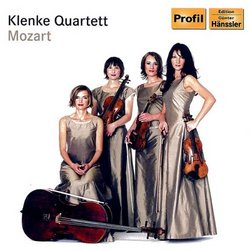| All Artists: Mozart, Klenke Quartett Title: Mozart: Klenke Quartett Mozart Members Wishing: 1 Total Copies: 0 Label: Profil - G Haenssler Original Release Date: 1/1/2008 Re-Release Date: 5/27/2008 Genre: Classical Styles: Chamber Music, Historical Periods, Classical (c.1770-1830) Number of Discs: 1 SwapaCD Credits: 1 UPC: 881488403022 |
Search - Mozart, Klenke Quartett :: Mozart: Klenke Quartett Mozart
CD Details |
CD ReviewsMore Marvelous Mozart Quartets from the Klenke Quartet J Scott Morrison | Middlebury VT, USA | 06/13/2008 (5 out of 5 stars) "I've raved about the playing of Klenke Quartet in its three earlier releases of Mozart quartets, the so-called 'Haydn Quartets', initially released as singles and then collected in a three-CD box at a bit of a price break. Mozart: The "Haydn" Quartets [Box Set] I found those performances to be nuanced, expressive and always forward-moving. (Another customer reviewer has, to be fair, criticized two of these three CDs but I simply cannot hear what that reviewer objects to. Read madamemusico's reviews and judge for yourselves.)
This release contains the two quartets that Mozart wrote a year and a half after the 'Haydn Quartets'. That is to say, these are the K499 in D major, and the K575, also in D major. If you look at those Köchel numbers you'll realize that these were written during one of Mozart's richest periods, one which produced the great D Minor piano concerto K488, 'Nozze di Figaro' K492, 'Eine kleine Nachtmusik' K525 and the last two symphonies, the great G Minor, K550 and the 'Jupiter', K551. Although the enclosed booklet doesn't use their familiar subtitles, these are the so-called 'Hoffmeister' and the First 'Prussian' Quartets, both masterpieces which come as close as anyone to being the equal of Haydn's own late quartets. K499's first movement has a newly minted contrapuntal complexity that masquerades as expansive simplicity, a marvel of construction. The menuetto comes second; its trio, called by Alfred Einstein 'a fencing feat of the highest order', looks forward to the finale beyond the slow third movement which is an achingly lyrical outpouring underpinned by oddly irresolute harmonies. The finale is one of the so-called sonata-rondo movements that Mozart was fond of and which Beethoven later imitated. It manages somehow to be both cheerful and sad. How Mozart accomplishes this in an unblemished G Major is one of the wonders of his late output. In some ways it foreshadows Schubert's ability to make us cry and chuckle at the same time. The Klenke have the full measure of the work. Their subtle phrasing, always dead-on intonation, and ability to always move things forward is a pleasure to hear. A great performance. K575, among Mozart's last quartets, is given an equally commanding performance. One notes how the Klenke manage to give rounded phrase endings without slowing down or unnecessarily emphasizing them. They have a consistent sweetness of tone, matched nicely by all four players, that does not become annoyingly saccharine. These characteristics are signs of deeply sophisticated playing. The first movement, an allegretto, is given an intensity that one sometimes does not hear in this music. It is followed by a songlike Andante, a graceful minuet and another sonata-rondo finale which is an exemplar of Mozart's ability to mix disparate elements into a seemingly inevitable whole. This issue confirms further for me that the Klenke Quartet, young though they be, are an ensemble to pay close attention to. Urgently recommended. Scott Morrison" |

